Nikon D7000 Review
Nikon D7000 Usability - How easy is it to use?
Ergonomics of the Nikon D7000 are generally quite good. The camera feels very solid with a good weight which gives it added stability. Among it closest competitors, it is the lightest but not the smallest. The body of the Nikon D7000 is tall but relatively narrow. This makes the grip tall enough for all fingers to wrap around it, at least for average-sized hands, something that is often unavoidable with smaller cameras. The grip itself is quite straight with a small protrusion and widening at the top where the front-control-dial is mounted. The protrusion barely helps support the camera though.
The shutter-release is mounted at the top of the grip with a slight angle. This is a standard two-stage release with moderate travel and a very soft halfway point. This makes easy to complete a shot without jolting the whole camera down but equally easy to take one accidentally. The front control-dial is within easy reach of the index finger from the shutter-release.
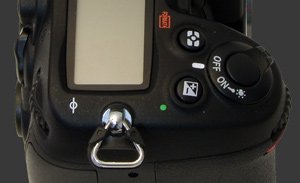 The top of the grip has the power-switch around the shutter-release and two buttons behind it. The EC button finds itself on the outer edge of the camera body. While it is within reach of the index finder, it is not comfortable to do so. Given that EC is one of the most used functions, it would have been much better to move it to where the the Metering button is. Speaking of the Metering button, it really should not be on top of the grip which is a premium location for functions used with the camera at eye-level. Instead, it would be better to have the ISO button where EC currently is and Metering in place of ISO. The worst part of the current placement is that it is possible to accidentally change metering modes while reaching for exposure-compensation and no indication gets shown in the viewfinder.
The top of the grip has the power-switch around the shutter-release and two buttons behind it. The EC button finds itself on the outer edge of the camera body. While it is within reach of the index finder, it is not comfortable to do so. Given that EC is one of the most used functions, it would have been much better to move it to where the the Metering button is. Speaking of the Metering button, it really should not be on top of the grip which is a premium location for functions used with the camera at eye-level. Instead, it would be better to have the ISO button where EC currently is and Metering in place of ISO. The worst part of the current placement is that it is possible to accidentally change metering modes while reaching for exposure-compensation and no indication gets shown in the viewfinder.
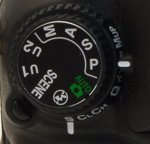 The top plate of the D7000 has the mode-dial stacked over a dial to select the drive-mode. The mode-dial is easy to grab and has good detents to prevent accidental changes. The drive-dial protrudes thinly outside of the mode-dial and uses a locking mechanism to release it. It may be difficult to use with gloves on but otherwise does its job. Strangely though, the lower-end Nikon D3100 has a better drive-mode switch.
The top plate of the D7000 has the mode-dial stacked over a dial to select the drive-mode. The mode-dial is easy to grab and has good detents to prevent accidental changes. The drive-dial protrudes thinly outside of the mode-dial and uses a locking mechanism to release it. It may be difficult to use with gloves on but otherwise does its job. Strangely though, the lower-end Nikon D3100 has a better drive-mode switch.
The rear of this DSLR is very ergonomic. There is a large 3" LCD with 920K pixels aligned with the optical viewfinder. The LCD is sharp with a wide viewing-angle and good refresh rate. Visibility is good and the anti-reflective coating works well.
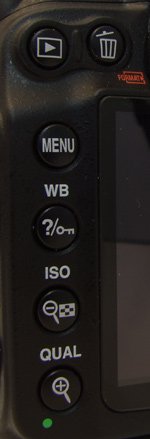 Towards the left of the LCD and OVF are 6 buttons, mostly arranged in a column. It is really great that there is such space to the left of the LCD. A number of modern DSLRs have the LCD flush with the edge of the camera which frequently causes the displays to get smudged. As anyone using sunscreen quickly discovers, it is very hard to clean it off in the field. Nikon also generously includes a protective plastic LCD cover with the D7000.
Towards the left of the LCD and OVF are 6 buttons, mostly arranged in a column. It is really great that there is such space to the left of the LCD. A number of modern DSLRs have the LCD flush with the edge of the camera which frequently causes the displays to get smudged. As anyone using sunscreen quickly discovers, it is very hard to clean it off in the field. Nikon also generously includes a protective plastic LCD cover with the D7000.
The top two buttons, Play and Delete, are easy to reach and work well together. Press Delete once to be prompted to delete the shown image. Press it again to confirm or press Play to cancel. This makes deleting images efficient. The column below those has 4 buttons: Menu, WB, ISO, Zoom Out and Zoom In. These buttons all do the obvious and their placement is reasonable except for ISO. Since this is a frequently changed parameter, it would be immensely better to place it in a distinct location that is easy to reach and identify with the camera at eye-level. Luckily, there is something called Easy ISO which is discussed along with the control-dials below.
The D7000 features dual control-dials which are easy to reach without shifting your grip. These dials have plenty of customization options affecting how they work. One may notice that Nikon dials turn the opposite way as all other manufacturers by default and even the contrary to common sense in some respects. Nikon thoughtfully includes options to reverse dials, switch them around and flip visual indicators.
Both controls dials are put to good use. Enabling Easy ISO in the configuration menu lets the otherwise-unused dial control ISO sensitivity. A similar option called Easy EC exists which makes the same dial apply exposure-compensation without having to hold-down the EC button.With Easy ISO enabled the dials therefore work as follows:
| Mode/ Button | Front Dial | Rear Dial |
|---|---|---|
| P | ISO | Program Shift |
| S | ISO | Shutter-Speed |
| A | Aperture | ISO |
| M | Aperture | Shutter-Speed |
| EC | EC | |
| Metering | Metering | |
| Bracketing | Increments | Frames |
| Flash | FC | Flash Mode |
| WB | WB | B-A Tuning |
| ISO | ISO |
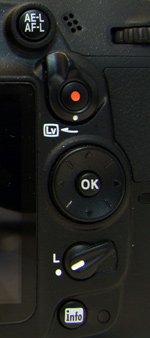 Towards the right of the LCD and OVF are a few controls. At the top, the large AE-L/AF-L button is well-placed. Just below it is a spring-loaded Live-View activation switch which surrounds the Video-Recording button. Below that is an 8-way controls which is used to move the autofocus point around, navigate menus and pan images. There is a lock switch to prevent accidentally moving the focus-point directly below the 8-way controller. Completely at the bottom is the Info button. Pressing it once shows a status screen, pressing it again lets the user one of 10 settings arranged in two rows along the bottom of the status screen.
Towards the right of the LCD and OVF are a few controls. At the top, the large AE-L/AF-L button is well-placed. Just below it is a spring-loaded Live-View activation switch which surrounds the Video-Recording button. Below that is an 8-way controls which is used to move the autofocus point around, navigate menus and pan images. There is a lock switch to prevent accidentally moving the focus-point directly below the 8-way controller. Completely at the bottom is the Info button. Pressing it once shows a status screen, pressing it again lets the user one of 10 settings arranged in two rows along the bottom of the status screen.
In operation, controls to the right of the LCD are rarely needed, particularly the lower onesFocus-Point Lock and Info. This will be greatly appreciate by users of hand-straps as those often hinder moving the hand down. Using a hand-strap, rather than the supplied neck-strap, makes a camera more discrete which helps with street and candid photography. This is something Nikon is managing better than everyone else so far.
The optical viewfinder is large and bright with 100% coverage. It features a simply status line below it and optional overlaid 3x3 grid and low-battery warning. Normally the rightmost item on the status line is the number of remaining frames. However, when Easy ISO is enabled, the same spot is used to display ISO instead. To see the number of remaining frames in the OVF, one has to press the Magnify button which is otherwise unused in Shooting mode.
The status line has a great manual-focus direction indicator which has only been soon on Nikon DSLRs so far. This indicator shows in which direction the lens needs to be focused. It also confirms when focus has been established at the center of the frame.
There is a single-axis digital-level which shows camera-tilt in the OVF when either the Function or DOF-Preview buttons is pressed. When this happens, the status line blacks out except for the tilt-indicator. Live-View has a completely different digital-level display which only appears by cycling though all available display modes using the Info button. This is excessively inefficient and, on top of that, Live-View does not honor button customization for invoking the digital-level.
While some constructive criticism regarding ergonomic were discussed above, Live-View is where this camera actually screws up. Many photographers could not care less. Video enthusiasts have to deal with some of it though since, there video depends on Live-View. The Live-View implementation of the D7000 has a number of important limitations:
- The view is not Exposure-Priority: This DSLR makes no attempt to preview a correct exposure. It does respond to EC but does so artificially without regards to the actual exposure brightness. There is no live histogram either.
- No DOF-Preview: The aperture used by Live-View is fixed and therefore it is impossible to preview depth-of-field. That is too bad because a large display is more suitable to show DOF than an small OVF which becomes much darker while doing so.
- Incorrect White-Balance: The Live-View changes according to the selected WB option but it does not reflect white-balance fine-tuning.
- Inconsistent Metering: The metering system used in Live-View differs from the one normally used.
- Enabling Video Manual Controls Cripples Live-View: It causes the shutter-speed to be limited to 1/30s and the aperture to be fixed.
The last point is another negative aspect of cameras which lack a video mode. This occurs because the camera does not know if it is about to shoot video or not. So, it limits the shutter-speed to a range compatible with video recording, making it impossible to reach certain shutter-speeds for photography! As usual, video framing poses difficulty as well. One of the display modes shows areas outside of the HD aspect-ratio shaded which are difficult to see over asphalt. Even when they can be seen, it takes practice to keep subjects from crossing outside of the video recording area. Thus display mode is mutually exclusive from other display modes, so one cannot frame for video while seeing the digital level too.
Like all DSLRs, the Nikon D7000 includes a metal tripod-mount aligned with the center of the lens. The battery-compartment is weather-sealed and has a small latch to prevent the battery from falling. It is also sufficiently far from the tripod mount to allow changing batteries while on a tripod unless using a rather large quickk-release plate. The powerfull battery used in the D7000 gives detailed information about status. An item in the Setup menu shows the current charge as a percentage and its age on a relative 5-step scale.
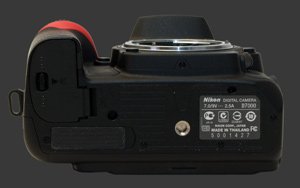
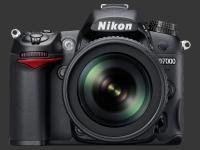 |
Please Support Neocamera
All information on Neocamera is provided free of charge yet running this website is a huge endeavor. Purchases made via affiliate links found throughout the site help keep it running and up-to-date. There is no additional cost to you, so please consider buying via these links to our affilates:
If you found any information on this site valuable and did not purchase via our affiliate links, please considering donating via PayPal:
Any amount will be greatly appreaciated. Thank you for your support!
Nikon D7000 Highlights

Sensor-Size: 24 x 16mm

Actual size when viewed at 100 DPI
| 16 Megapixels DSLR | ISO 100-25600 |
| Nikon F Mount 1.5X FLM | Shutter 1/8000-30s |
| 100% Coverage Large Viewfinder | Full manual controls, including Manual Focus |
| 1 Axis Digital Level | Custom white-balance with 2 axis fine-tuning |
| Weatherproof | Spot-Metering |
| Built-in Dust Reduction | Hot-Shoe |
| 6 FPS Drive, 100 Images | Stereo audio input |
| 1920x1080 @ 24 FPS Video Recording | Lithium-Ion Battery |
| 3" LCD 920K Pixels | Secure Digital Extended Capacity x 2 |
Updates
2024.04.03

Fujifilm X-T5 Review
Newest Fujifilm flagship boasting a 40 MP APS-C sensor, 5-axis IBIS with 7-stop efficiency, 15 FPS continuous drive, 6.2K Video capture, dual control-dials and dual SDXC UHS-II slots in a sturdy weatherproof and freezeproof body.
2023.11.20

Best Digital Cameras of 2023
Find out which are the Best Digital Cameras of 2023. All the new Mirrorless Digital Cameras from entry-level to high-end professional.
2023.07.10

Fujifilm X-H2 Review
40 Megapixels APS-C Hybrid Mirrorless Digital Camera with 7-stop IBIS. Fastest shutter ever and 8K video capture. Large builtin EVF with 0.8X magnification and 5.8 MP, plus an Eye-Start Sensor. Packed with features and large number of controls in a weatherproof and freezeproof body.
2023.05.07

Sony FE 20-70mm F/4G Review
Review of the unique Sony FE 20-70mm F/4G lens. The optical zoom of this lens spans ultra-wide-angle and medium focal-length coverage, making it one of the most versatile Full-Frame lenses on the market.
2023.01.15

Huion Inspiroy Dial 2 Review
Review of the Huion Inspiroy Dial 2 tablet, a medium sized drawing surface with dual dials and customizable buttons. Connects via USB-C or Bluetooth 5.0 with Windows, Linux and Android support.
2022.12.08

How to Pack for a Photo Trip
Find out how to pack for a travel photography trip, carry your gear safely while meeting airline regulations.
2022.11.13

Best Digital Cameras of 2022
The best digital cameras of 2022. A short list of the most outstanding models in their respective categories. Choose one for yourself or as a gift.
2022.09.21

Pentax DA* 60-250mm F/4 SDM Review
Review of the Pentax DA* 60-250mm F/4 SDM, the constant-aperture telephoto zoom with the highest zoom-ratio on the market.
2022.09.20

Pentax DA* 50-135mm F/2.8 SDM Review
Review of the Pentax DA* 50-135mm F/2.8 SDM, the lightest professional telephoto zoom native to the K-mount.
2022.09.10

Pentax DA* 11-18mm F/2.8 DC AW Review
Review of the Pentax DA* 11-18mm F/2.8 DC AW, the widest professional ultra-wide zoom native to the K-mount.
2021.11.24

50 Gifts Under $50 For Photographers in 2021
50 Gifts photographers will love. All for under $50 USD. 2021 Edition.
2021.11.17

Best Digital Cameras for 2021
Neocamera shows which are the very best Digital Cameras for 2021 in every category: Mirrorless, DSLR, Premium Compact, Ultra-Zoom and Rugged.













